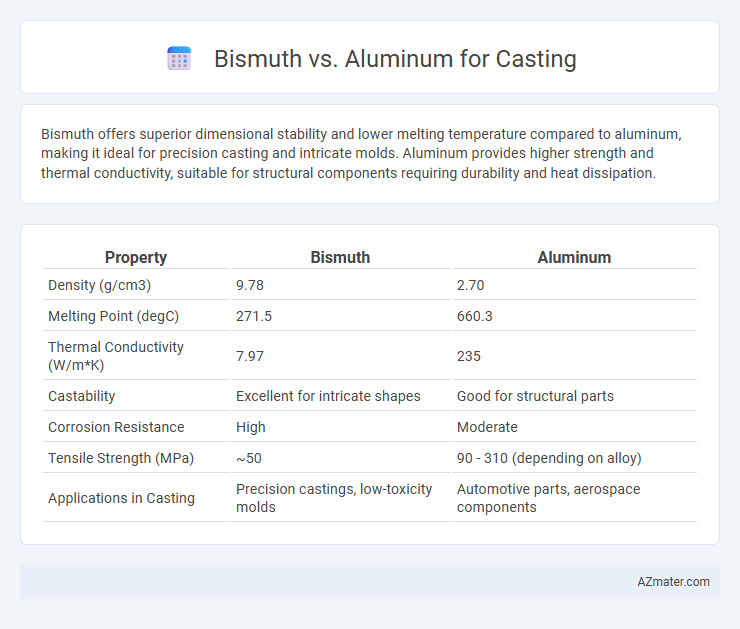Bismuth offers superior dimensional stability and lower melting temperature compared to aluminum, making it ideal for precision casting and intricate molds. Aluminum provides higher strength and thermal conductivity, suitable for structural components requiring durability and heat dissipation.
Table of Comparison
| Property | Bismuth | Aluminum |
|---|---|---|
| Density (g/cm3) | 9.78 | 2.70 |
| Melting Point (degC) | 271.5 | 660.3 |
| Thermal Conductivity (W/m*K) | 7.97 | 235 |
| Castability | Excellent for intricate shapes | Good for structural parts |
| Corrosion Resistance | High | Moderate |
| Tensile Strength (MPa) | ~50 | 90 - 310 (depending on alloy) |
| Applications in Casting | Precision castings, low-toxicity molds | Automotive parts, aerospace components |
Introduction to Bismuth and Aluminum Casting
Bismuth and aluminum are metals commonly used in casting due to their unique physical and chemical properties. Bismuth offers a low melting point of around 271degC, excellent dimensional stability, and minimal shrinkage, making it ideal for detailed patterns and precision castings. Aluminum casting benefits from its lightweight nature, higher melting point of approximately 660degC, and strong corrosion resistance, which suits structural and automotive components requiring durability.
Physical Properties Comparison
Bismuth exhibits a low melting point of 271.4degC compared to aluminum's significantly higher melting point at 660.3degC, making bismuth ideal for low-temperature casting applications. The density of bismuth is approximately 9.78 g/cm3, much higher than aluminum's 2.70 g/cm3, affecting the weight and thermal conductivity of cast parts. Aluminum offers superior thermal conductivity around 235 W/m*K, whereas bismuth's conductivity is only about 7.97 W/m*K, influencing cooling rates and mold design during casting processes.
Melting Points and Casting Temperatures
Bismuth has a melting point of 271.5degC, making it ideal for low-temperature casting applications where precision and minimal thermal stress are required. Aluminum melts at a significantly higher temperature of 660.3degC, which suits high-strength and durable castings but demands higher energy consumption and more robust mold materials. Selecting bismuth or aluminum for casting hinges on required melting points and the thermal properties of the final product.
Casting Techniques: Bismuth vs Aluminum
Bismuth offers superior dimensional stability and low melting points in casting compared to aluminum, making it ideal for precision casting techniques such as investment casting and low-temperature molds. Aluminum casting requires higher temperatures, typically between 660degC and 750degC, limiting its use to methods like die casting and sand casting. The choice between bismuth and aluminum castings depends on factors like thermal conductivity, melting range, and application-specific requirements for surface finish and structural integrity.
Surface Finish and Detail Reproduction
Bismuth alloys offer superior surface finish and intricate detail reproduction compared to aluminum in casting due to their low melting point and reduced shrinkage characteristics. Aluminum tends to produce rougher surfaces and less precise details because of higher melting temperatures and greater oxidation during solidification. Consequently, bismuth is preferred for applications requiring finely detailed, smooth cast components such as jewelry and precision molds.
Safety Considerations in Casting
Bismuth alloys offer superior safety in casting due to their low melting points and non-toxic properties, reducing the risk of burns and harmful fumes compared to aluminum, which melts at a much higher temperature and can emit hazardous smoke. The lower casting temperature of bismuth minimizes thermal stress on molds and lowers energy consumption while enhancing operator safety by decreasing exposure to high heat. Aluminum, while cost-effective and strong, requires stringent ventilation and protective gear to manage risks associated with molten metal splatter and toxic oxide fumes during the casting process.
Cost and Material Availability
Bismuth alloys offer superior expansion control and better surface finish in casting but come at a significantly higher cost compared to aluminum, which remains more affordable and widely available due to extensive global production. Aluminum's abundance and low price make it the preferred choice for large-scale manufacturing, while bismuth's niche applications justify its premium price in precision casting where material stability is critical. Cost-efficiency and supply chain reliability favor aluminum, but specific casting requirements can necessitate the investment in bismuth for optimized performance.
Applications in Industry and Hobby
Bismuth is favored in casting for low-melting alloys used in precision molds, jewelry, and small-scale hobby projects due to its non-toxic, environmentally friendly properties and excellent dimensional stability. Aluminum casting dominates in automotive, aerospace, and heavy machinery industries because of its superior strength-to-weight ratio, thermal conductivity, and corrosion resistance. Hobbyists prefer bismuth alloys for intricate designs and lead-free safety, while aluminum offers durability for functional prototypes and larger mechanical parts.
Environmental and Health Impacts
Bismuth, a non-toxic and environmentally benign metal, offers significant advantages over aluminum in casting by reducing hazardous emissions and minimizing toxic waste generation. Unlike aluminum, which requires energy-intensive processing and releases harmful greenhouse gases and particulate matter, bismuth's low melting point and non-reactive nature contribute to safer workplace conditions and lower carbon footprints. Casting with bismuth alloys supports sustainable manufacturing through recyclable materials and diminished exposure to metal dust and fumes, promoting improved occupational health and environmental conservation.
Choosing the Right Metal for Your Casting Project
Bismuth offers superior dimensional accuracy and minimal shrinkage during casting, making it ideal for intricate molds and precision components. Aluminum provides excellent strength-to-weight ratio and thermal conductivity, suitable for durable, lightweight parts in automotive and aerospace industries. Selecting between bismuth and aluminum depends on the specific casting requirements, including detail resolution, mechanical properties, and thermal performance.

Infographic: Bismuth vs Aluminum for Casting
 azmater.com
azmater.com